«previous pageCOMMUNICATIONS CATEGORY
Honor Award
Tucson's Urban Wildlife Walk
Kimberly Creagan, Student ASLA
The University of Arizona, Tucson, AZ
faculty advisors: Margaret Livingston, ASLA, Lauri Macmillan Johnson, ASLA, and
Elizabeth Scott, ASLA
Project Statement
As a collective body, the public can significantly change the face of our urban environments by supporting and increasing habitat in their own neighborhoods. The Tucson Urban Wildlife Walk is an interpretive website that communicates the importance of urban wildlife habitat to Tucson residents and tourists. Developed in conjunction with a self-guided walking tour, the website hosts a virtual tour of potential habitats downtown and inspires residents to create their own backyard habitat.
Project Narrative
Purpose
The Tucson Urban Wildlife Walk website is a major component of a master's report which explores strategies for increasing habitat in the most urbanized part of Tucson. The process involved an inventory and analysis of potential habitat sites on municipal property, design of an interpretive walking tour, and detailed site designs for two tour stops. The interpretive website and tour pamphlet were created in conjunction with the report as a tool to educate the public about potential wildlife habitat, where it exists, and how they can improve habitat in their own yards and neighborhoods.
Context and Need
The Sonoran Desert is the most biologically diverse of the four United States deserts and home to many endemic species that cannot be found anywhere else in the world. But like many places, habitat is being destroyed to make way for development. Pima County, in which Tucson is located, has done a comparatively good job of setting aside large habitat reserves for wildlife, but they are often isolated patches surrounded by a sea of development. To allow these reserves to function better for wildlife, they must be connected by making use of the urban environment. Smaller, urban habitat patches can act to supplement these larger reserves by providing more options for food and shelter or acting as stepping stones for migration.
Audience
The website is designed for both residents of Tucson and tourists. Much of the material on the website is written in a way that will appeal to a younger audience for several reasons. First, parents will be able to use the website and tour as an activity to do together. Second, schools may use the website as an educational tool and resource for creating schoolyard habitats. In addition, children often have an enthusiasm for learning about wildlife and their excitement can inspire adults. The younger population is the future of Tucson, so instilling an appreciation for wildlife and the Sonoran Desert at a young age will benefit Tucson in the future. Although the tone of the website is geared toward children, adults will find it a simple and useful tool for learning about urban wildlife or creating habitat in their yard.
Distribution Method
The website is hosted on its own Internet domain and a link is provided from the City of Tucson website.
Message and Design
There are five main sections to the website. The first, "Sonoran Desert Habitat," teaches the user about habitat characteristics and what makes the Sonoran Desert such a unique place. It also describes some important habitat types, the state of habitat in the urban environment, and the benefits of microclimates.
The second section, "Meet the Wildlife," allows users to learn more about wildlife that they may find in urban Tucson. Pop-up windows act as a sort of field guide that describe the needs of four different wildlife types: birds, small mammals, insects, and reptiles. This section also has a game in which users can match up a quote from an animal with its picture.
The third section, "Take the Tour," allows users to navigate a virtual tour of downtown habitats. On the main tour page they will see a map of the three tour routes with icons that correspond to each tour stop. There is also a button here to download the corresponding interpretive pamphlet to take with when doing the walking tour downtown. Each tour route has a primary interpretive theme and a secondary theme that varies. For instance, the primary theme of the red route focuses on habitat design characteristics and the secondary theme discusses ways of improving habitat for a particular type of wildlife. Clicking on a tour stop icon will direct one to a pop-up window of that tour stop with pictures of the stop and fun information relating to the interpretive theme. Users can see examples of places that are good potential habitat or see suggestions of how a location can be improved. Several stops have images that the user can roll their mouse over to see an example of how that stop would look if improved.
The forth section, "Create Your Own Habitat," gives users tips for improving habitat in their own yard or neighborhood. Each habitat design principle has an icon to the left that corresponds to the tour stop with a similar theme. When the icon is clicked, it takes the user to the pop-up window for that tour stop.
The last section, "Additional Resources," contains links to other websites that will provide more information about building habitat. These links are broken down into three sections: Tucson Area Wildlife, Plants for Native Wildlife, and Creating Habitat at Home.
Potential Impact
There are several long-term impacts that this project has the potential to achieve, especially once the physical tour is fully implemented by the city of Tucson. First, it can educate Tucson residents about the importance of native wildlife and inspire them to improve habitat in their own yards and neighborhoods. In doing so, it has the potential to improve habitat and connections for wildlife, promoting healthier wildlife populations and enriching the downtown experience for humans. Additionally, it can enhance downtown Tucson with an aesthetically unique experience that is rooted in place.
Additional Project Credits
Irene Ogata
City of Tucson
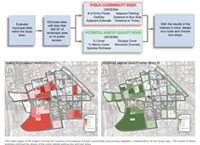
The initial stages of the project involved an inventory and analysis of public accessibility and existing vegetation characteristics for the study area. The results of these analyses informed the design of the urban habitat walking tour and tour stops. (Photo: Kimberly Creagan)
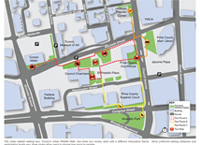
The urban habitat walking tour, Tucson’s Urban Wildlife Walk, has three tour routes, each with a different interpretive theme. Since preferred walking distances and participation levels vary, three routes allow users to choose how much to partake. (Photo: Kimberly Creagan)
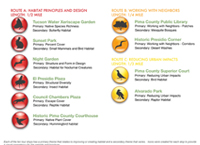
Each of the ten tour stops has a primary theme that relates to improving or creating habitat and a secondary theme that various. Icons were created for each stop to provide a visual consistency for the website and brochure. (Photo: Kimberly Creagan)
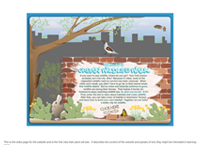
This is the index page for the website and is the first view that users will see. It describes the content of the website and speaks of why they might be interested in learning more. (Photo: Kimberly Creagan)
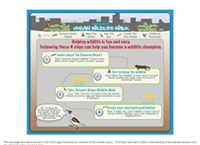
The next page that users will see is this home page that gives an overview of the website layout. This helps users get a better understanding of the website structure and the information they can learn here. (Photo: Kimberly Creagan)
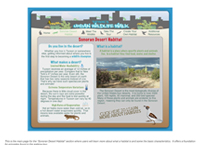
This is the main page for the “Sonoran Desert Habitat” section where users will learn more about what a habitat is and some the basic characteristics. It offers a foundation for principles found in the walking tour. (Photo: Kimberly Creagan)
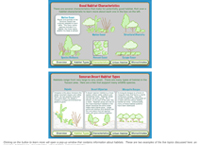
Clicking on the button to learn more will open a pop-up window that contains information about habitats. These are two examples of the five topics discussed here: an overview, habitat types, characteristics, urban habitat, and microclimates. (Photo: Kimberly Creagan)
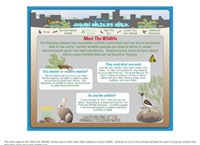
The main page for the “Meet the Wildlife” section gives a few basic facts relating to urban wildlife. Clicking on one of the animals will take the user to a pop-up window that describes more about that wildlife type. (Photo: Kimberly Creagan)
"This brings up really good topics and is chock full of important information. Children will love this and respond. The cuteness belies the depth of the information available. Nice work."
— 2009 Student Awards Jury
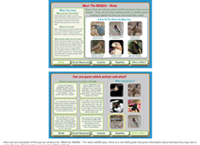
Here are two examples of the pop-up windows for “meet the Wildlife.” For each wildlife type, there is a mini field guide that gives information about animals they may see in urban Tucson. There is also a game called “Who’s Who?” (Photo: Chris Brown, Ron Groves, James Phelps, Steve Ryan, Ken Thomas, United States Fish and Wildlife Services, United States Forest Service, Mark Wagner, Alan D. Wilson)
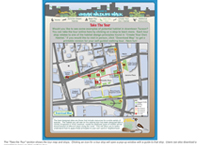
The “Take the Tour” section shows the tour map and stops. Clicking an icon for a tour stop will open a pop-up window with a guide to that stop. Users can also download a pamphlet to bring on their walking tour. (Photo: Kimberly Creagan)
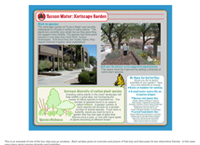
This is an example of one of the tour stop pop-up windows. Each window gives an overview and picture of that stop and discusses its two interpretive themes. In this case, users learn about species diversity and butterflies. (Photo: Kimberly Creagan)
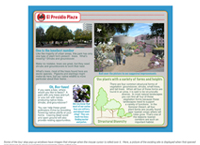
Some of the tour stop pop-up windows have images that change when the mouse cursor is rolled over it. Here, a picture of the existing site is displayed when first opened and changes to show suggested improvements when rolled over. (Photo: Kimberly Creagan)
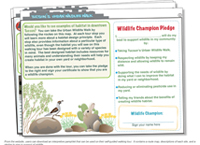
From the website, users can download an interpretive pamphlet that can be used on their self-guided walking tour. It contains a route map, descriptions of each site, and a pledge to sign in support of wildlife. (Photo: Kimberly Creagan)
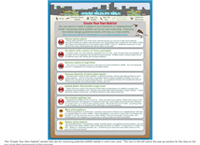
The “Create Your Own Habitat” section lists tips for improving potential wildlife habitat is one’s own yard. The icon to the left opens the pop-up window for the stop on the tour route that corresponds to that principle. (Photo: Kimberly Creagan)
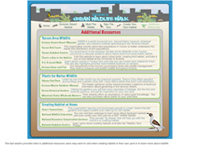
The last section provides links to additional resources users may want to visit when creating habitat in their own yard or to learn more about wildlife. (Photo: Kimberly Creagan)



